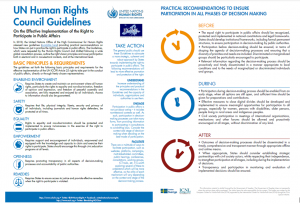In the town of Peñalolén, Chile, there is a special kind of fiesta going on: a one-month party celebrating local participation. It
centres on a communal decision-making process where everyone contributes ideas for the Peñalolén Community
Development Plan. The local government has pledged to prioritise the most relevant projects for the neighbourhoods that locals suggest, making local governance more transparent, inclusive, modern and innovative.
The fiesta, a pilot project supported by the Ciudadano Inteligente, was conceived as a fun process, but it is also a serious affair. It requires extensive preparation, deliberation and logistics to ensure its success and sustainability. The organizers know that for participation to be effective, both government officials and ordinary people must have a thorough understanding of what participation is and how it works. In order to boost this type of understanding – and practical knowledge about conducting similar processes – the UN Human Rights Council (HRC) and the UN Office of the High Commissioner for Human Rights (OHCHR) recently published Guidelines on effectively implementing the right to participate in public affairs. The Guidelines, which provide practical recommendations to both States and civil society, outline the right’s basic principles and emphasise the need to provide a safe, conducive environment for people to participate freely. They also highlight states’ obligation to be accountable and transparent when making decisions and to encourage diverse groups to join in the process without discrimination. The Guidelines emphasise that the Sustainable Development Goals place particular emphasis on the participatory process, notably through goal 16, which includes targets to ensure responsive, inclusive, participatory and representative decision-making at all levels.
Participation allows the public to become empowered as drivers of change, as opposed to being viewed as vulnerable and passive recipients of services. The Guidelines draw significant legitimacy from the fact that the OHCHR walked the talk in developing them, putting the principle of public participation into action. The final product was the result of an unprecedented year-and-a-half-long consultation process, which engaged numerous and diverse stakeholders both online and through in-person workshops organized in five different regions (all of the background reports, written submissions and conclusions from the workshops are made available here). Thanks to this participatory process, the Guidelines are full of practical tips drawn from contexts all over the world, some of which you can explore in our briefer. While the Guidelines do not impose any hard-law obligations regarding the right to participate in public affairs, Article 25 of the ICCPR does - and the Guidelines give a roadmap on how States can implement this right. This point was emphasised during debates over the HRC Resolution on Equal participation in political and public affairs.
ECNL encourages governments, civil society, donors, intergovernmental institutions and other stakeholders to make use of the Guidelines and keep building good practice, to lead by example and to show the true benefits of public engagement beyond elections.
- OHCHR ECNL briefer on the Guidelines
- OHCHR website on the Guidelines on the right to participate in public affairs
